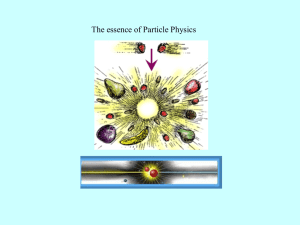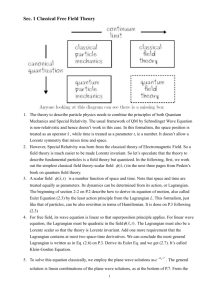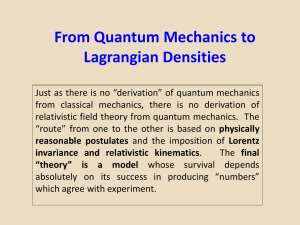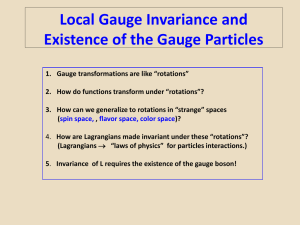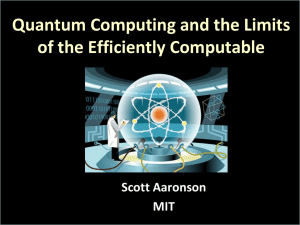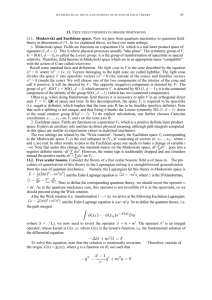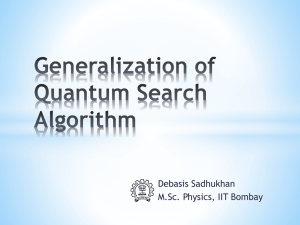Power Point File
advertisement
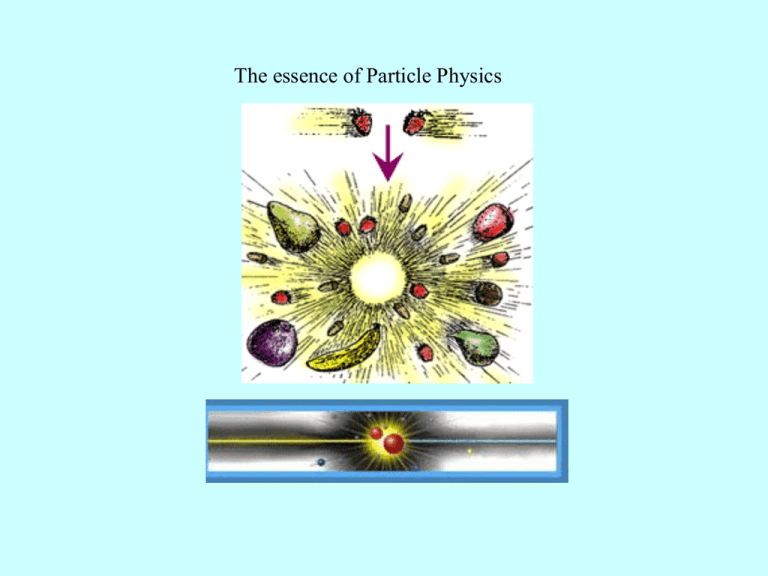
The essence of Particle Physics The essence of Particle Physics Particles are actually not like balls but essentially more fields! Well, not quite. They are quantized fields. Fields when quantized are not like fields any longer, but more like particles. Quantum Field Theory Classical Field Theory f ( x, t ) f ( xm ) Space and time are treated equally as parameters. It is manifestly Lorentz Invariant. But they are quantized fields. Dirac Notation of Quantum Mechanics 狀態 Ket 所有狀態組成一向量空間 Bra 此向量空間的 Dual 空間 物理量 算子 operator Oˆ Oˆ 在狀態Ψ時,物理量測量期望值等於 Oˆ 與 的內積 ( ) ( ) Oˆ = Y Oˆ Y = Y Oˆ + Y = Y Oˆ Y 𝑂 算子夾在 Ψ 及 Ψ 間的 matrix element 在波動力學中,以上的體系就對應到波函數及其運算! 狀態 波函數 (x ) 測量 運算子 Oˆ 例如 i x 測量期望值 Oˆ * ( x) Oˆ ( x)dx 波函數 (x ) 就是以 x 為基底表示的向量分量! 你一樣可以選擇其他基底例如: p 波函數Ψ 𝑥 就是 Ψ 在 𝑥 的投影: ( x) x * ( x) x Classical Field Theory f ( x, t ) f ( xm ) Space and time are treated equally as parameters. It is manifestly Lorentz Invariant. Quantum Field Theory f ( xm ) fˆ ( x m ) For a quantum theory of field, the field is promoted to operators! It is still manifestly Lorentz Invariant. Particle Quantum Mechanics x(t ) ˆ x(t) Space is operator while time remains a number parameter. That is why Particle QM can not be Lorentz invariant. 場的觀念原來是來自一個粒子系統的連續極限! y ri (t) ® yi (t) i =1 N 粒子排列整齊,編號自然以平衡時的水平位置最自然! 當粒子間隔區向無限小,離散足標趨向連續變 數: ix yi (t ) y( x, t ) 所以位置基本上是足標,但與時間一樣都是數字! 注意以上只是一個有用的比喻。 場並不必然需要有粒子系統的存在,例如電場。 Classical Field Theory j ( x, t ) ® j ( x m ) It is just like electric field but simpler. ϕ is a scalar not a vector as electric field: E It is easiest to describe fields using Lagrangian and Hamiltonian. x Action is defined as the integral over time of the Lagrange. S= 𝐿 𝑑𝑡 The equation of motion is given by the principle of Least Action. For the fields spreading over space, the Lagrangian would be the integral over space of the Lagrange Density (Lagrangian) ℒ. L= ℒ 𝜙 𝑥 , 𝜕𝜇 𝜙 𝑥 Hence the action is an integral over spacetime. 𝑑3 𝑥 Hence the action is a integral over spacetime. The integration is Lorenz Invariant. 𝑑 4 𝑥 = 𝑑 4 𝑥′ The Lorenz invariance of the Lagrangian density will guarantee the Lorenz invariance of Action. If ℒ 𝜙 𝑥 , 𝜕𝜇 𝜙 𝑥 =ℒ 𝜙′ 𝑥 ′ , 𝜕 ′𝜇 𝜙′ 𝑥′ then 𝑆 = ℒ 𝜙 𝑥 , 𝜕𝜇 𝜙 𝑥 𝑑 4 𝑥 == ℒ 𝜙′ 𝑥 ′ , 𝜕 ′𝜇 𝜙′ 𝑥′ The invariance of Action under Lorentz transformation will guarantee the invariance of equation of motion! 𝑑 4 𝑥′ = 𝑆′ The equation of motion is given by the principle of Least Action. Under arbitrary change of fields f ( x ) ® f ( x ) + df ( x) the change of action is zero 𝛿 𝜕𝜇 𝜙 = 𝜕𝜇 𝛿𝜙 Euler Equation 有了Lagrangian L,場的運動方程式即可得出。 有了Lagrangian L,場的運動方程式即可得出。 Euler Equation 純量場最簡單的 Lagrangian: ℒ= 1 1 𝜕𝜇 𝜙 𝜕𝜇 𝜙 − 𝑚2 𝜙 2 2 2 代入Euler Equation,得到: m 2 0 Klein-Gordon Equation 滿足羅倫茲不變性的 ϕ 之最簡單的線性運動方程式 ¶2 (¶m ) (¶ ) = ¶t 2 - Ñ × Ñ m m 2 0 ¶2 (¶m ) (¶ ) = ¶t 2 - Ñ × Ñ m 2 m2 0 Klein-Gordon Equation m 2 0 Klein-Gordon Equation 這個方程式在一維空間就和連續弦幾乎一樣,只是多了最後一項: 2 y 2 y 2 x t 2 2 m 2 0 Klein-Gordon Equation 滿足羅倫茲不變性的 ϕ 之最簡單的線性運動方程式 尋找 ϕ 的運動方程式是線性的,L 必須由場及其一次微分的平方組成 1 1 2 2 𝜇 ℒ = 𝜕𝜇 𝜙 𝜕 𝜙 − 𝑚 𝜙 2 2 若再要求 Lagrangian 是 Lorenz Invariant,以上為最簡單的選擇。 此 Lagrangian 是 Lorenz Invariant,因此運動方程式亦是 Lorenz Invariant 。 Solving KG Equation: 2 m2 0 Expand the KG field in terms of Fourier Series 對空間微分簡 化為動量乘積 Plug into KG Eq.: 2 2 t E t 0 p p p t 2 Every Fourier Component 𝜙𝑝 behaves like a SHO with ω p Ep 2 p m2 KG Field is just a collection of SHO’s. Each SHO is characterized by its k or p “momentum”. The frequency ω or “energy” of the SHO is just that of a relativistic particle with mass m. 物體的變形可以被分類為一個一個特定的模式 Norm! 每一個模式都是一個簡諧運動 每一個模式,對應一個內在的特定的振動頻率! 物體的變形就是以以上模式或其疊加來進行! 這就是場: 量子彈簧 e 一個如電子的微觀粒子,位於一個彈簧般的位能 內: E 1 2 1 2 kx p 2 2m 測不準原理強制微觀的位置及動量無法同時測準! 位置與動量是無法交換的算子 1 2 1 2 ˆ E kxˆ pˆ 2 2m 無法同時測準的位置及動量導出驚人的結果: 量子彈簧的能量不是如一般彈簧般是連續的, 而是固定量子的整數倍的離散型式。 量子(Quantum) 的大小與頻率成正 比! E hf E hf 粒子數目可改變的粒子系統的狀態的能量正是這樣的能階! 量子彈簧就對應到不可分割的粒子 2 2 t E t 0 p p p t 2 KG Field is just a collection of SHO’s. Every Fourier Component 𝜙𝑝 behaves like a SHO with ω p Ep 2 p m2 如果這些SHO也是量子彈簧,它們就對應到能量為 Ep 的粒子系統 如果 p 即是動量,這些粒子就正好是滿足相對論動量能量關係的粒 子。 量子化的KG場事實上是相對論粒子! 以上的討論可以推廣到複數場 ℒ = 𝜕𝜇 Φ∗ 𝜕𝜇 Φ − 𝑚2 Φ∗ Φ 如果將此複數場分解為其實數部及虛數部兩個場: Φ= 𝜙1 + 𝑖𝜙2 2 1 1 2 2 1 1 2 2 𝜇 𝜇 ℒ = 𝜕𝜇 𝜙1 𝜕 𝜙1 − 𝑚 𝜙1 + 𝜕𝜇 𝜙2 𝜕 𝜙2 − 𝑚 𝜙2 2 2 2 2 實數部與虛數部分解為獨立的 Klein Gordon 場 可見實數部及虛數部皆滿足 KG 方程式 因此整個複數場也滿足 KG 方程式 2 m 2 0 2 m2 0 這個結果也可以用一個技巧來推導: 將Φ及Φ∗ 視為獨立變數,代入個別的Euler Equation即可 結果立刻可以看見,注意在 Lagrangian 中的項可以作部分積分而忽略表面項 ℒ = 𝜕𝜇 Φ∗ 𝜕𝜇 Φ − 𝑚2 Φ∗ Φ → − Φ∗ 𝜕𝜇 𝜕𝜇 Φ − 𝑚2 Φ∗ Φ = − Φ∗ ∙ 𝜕 2 Φ − 𝑚2 Φ 對 Φ∗ 變分, Lagrangian 與其微分無關,因此只須考慮: 𝜕ℒ 𝜕Φ∗ 𝜕 2 Φ − 𝑚2 Φ = 0 Non-Relativistic Field Theory 1 ℒ = 𝑖𝜑 𝜕0 𝜑 − 𝛻𝜑∗ ∙ 𝛻𝜑 − 𝑔2 𝜑∗ 𝜑 2𝑚 ∗ 2 複數場 𝜑 和它的複數共軛 𝜑 ∗ ,在推導運動方程式時看成獨立的變數 𝜕 𝜕ℒ 𝜕𝑡 𝜕 𝜕𝜙 𝜕𝑡 𝜕 𝜕ℒ 𝜕𝑡 𝜕 𝜕𝜑 ∗ 𝜕𝑡 +𝛻∙ 𝜕ℒ 𝜕 𝛻𝜑∗ +𝛻∙ − 𝜕ℒ 𝜕 𝛻𝜙 𝜕ℒ − =0 𝜕𝜙 𝜕ℒ 1 2 𝜑∗ 𝜑 𝜑 = 0 → − 𝛻 ∙ 𝛻𝜑 − 𝑖𝜕 𝜑 − 2𝑔 0 𝜕𝜑 ∗ 2𝑚 1 𝛻 ∙ 𝛻𝜑 + 2𝑔2 𝜑∗ 𝜑 𝜑 = 0 2𝑚 Schrodinger Equation 𝜕ℒ 𝜕 1 − → 𝑖 𝜑∗ − 𝛻 ∙ 𝛻𝜑∗ − 2𝑔2 𝜑∗ 𝜑 𝜑∗ = 0 𝜕𝜑 𝜕𝑡 2𝑚 𝑖𝜕0 𝜑 + 𝜕 𝜕ℒ 𝜕𝑡 𝜕 𝜕𝜑 𝜕𝑡 +𝛻∙ 𝜕ℒ 𝜕 𝛻𝜑 這與上式是一致的。 The symmetry of Complex KG Field ℒ = 𝜕𝜇 Φ∗ 𝜕𝜇 Φ − 𝑚2 Φ∗ Φ The Lagrangian is invariant under the phase transformation of the field operator: ( x) e iQ ( x) 在量子力學中,複數物理量的 phase 是無法觀測的! eiQ eiQ (x) eiQ e iQ (x) U(1) Abelian Symmetry 這個對稱變換是由一個連續變數 𝜃 標定。 SU(N) Non-Abelian Symmetry Assume there are N fields: 1 2 3 n 𝑛 𝜕𝜇 Φ𝑖∗ 𝜕𝜇 Φ𝑖 − 𝑚2 Φ𝑖∗ Φ𝑖 ≡ 𝜕𝜇 Φ† 𝜕𝜇 Φ − 𝑚2 Φ† Φ ℒ= 𝑖=1 This Lagrangian is invariant under SU(N)! ( x) U ( x) e i T ( x) i i Φ† Φ → Φ† 𝑈 † 𝑈Φ = Φ† Φ If the particles have identical masses, the free theory has a SU(N) symmetry! Isospin SU(2)變換 u u U d d 在 Isospin SU(2)變換之後,強交互作用將運作如常,並沒有變化! 2 × 2 矩陣 U 如同旋轉一般可以以三個角度 (like Euler Angles)來標定 Every particle corresponds to a field. u Particle u (x) Field u ( x) u ( x) U 1 , 2 , 3 d ( x) d ( x) ℒ= 𝜕𝜇 𝑢† 𝜕𝜇 𝑢 − 𝑚2 𝑢† 𝑢 + 𝜕𝜇 𝑑 † 𝜕𝜇 𝑑 − 𝑚2 𝑑 † 𝑑 The Lagrangian is invariant under SU(2) U (1 ,2 ,3 ) 2 m2 0 求解: d p ip x ( x, t ) p, t e 3 2 3 對Φ作 Fourier 展開: 代入KG Equation: 2 2 p, t E p p, t 0 2 t 2 For every p, the frequency of the SHO has two solutions: E p E p p m2 ( p, t ) a p e iEt c p eiEt 代回 Fourier展開式:可得KG Equation的一般解 3 d p d p iEt ip x iEt ip x ( x) a p e c p e 3 3 2 2 3 These SHO’s correspond to the plane wave solutions of KG Eq. e -iEt+ip×x iEt+ip×x or e 對無交互作用的非相對論性場論可以用同樣方法求解: 1 𝑖𝜕0 𝜑 + 𝛻 ∙ 𝛻𝜑 = 0 2𝑚 d p ip x ( x, t ) p, t e 3 2 3 對𝜑作 Fourier 展開: 代入場 Equation: p p i p, t p, t 0 t 2m 此式的解就是複數的指數函數: 𝑝2 𝐸𝑝 = 2𝑚 iE p t ( p, t ) a p e d3p iE p t ip x ( x) a p e 3 2 A general solution is a linear superposition of all plane waves. 3 d p d p iEt ip x iEt ip x ( x) a p e c p e 3 3 2 2 3 3 d p d p' iEt ip x iEt ip ' x a p e c p ' e 3 3 2 2 3 d3p d p' + iEt-ip'×x -iEt+ip×x =ò ap × e +ò bp' × e 3 3 ( 2p ) ( 2p ) 3 = ò d3p ( 2p ) ( ) ( -ip×x + ip×x a × e + b × e ) p 3( p p' p ) 𝑝 ∙ 𝑥 = 𝐸𝑡 − 𝑝 ∙ 𝑥 Explicitly Lorentz Invariant The solution of complex KG Equation: d p ip x ip x e e x a b p p 3 2 3 For real field: The real solution of KG Equation: f ( x) = ò d3 p ( 2p ) -ip×x + ip×x a × e + a × e ) p 3( p To quantize the field theory, it’s easier to use Hamiltonian Formalism pi = ¶L ¶qi H º å pi qi - L i For field system, remember the space coordinates are just indices = d 3x Conjugate Momentum For Klein-Gordon Fields: x L x δ t 非相對論性量子力學的原則 pˆ i x xˆ x 所有古典物理的數字物理量在量子力學中都對應於 一個作用在波函數上的運算動作! 這些運算動作將代表狀態的波函數映射到另一個波函 數! x Oˆ ˆ x O 而這個物理量測量的期望值可以計 算: Oˆ * ( x) Oˆ ( x)dx 那些物理量是確定的? 確定的物理量 O 算子化為數 Oˆ o 作用於測量結果確定的狀態,算子的效果與數一樣,數 o 就是確 定的測量結果。 對一物理量測量結果確定的狀態就是該物理量算子的本徵態。 此確定的測量值即本徵值。 Oˆ o 本徵函數 Eigenfunction 本徵值 Eigenvalue 測量一個物理量時的不確定性是由測量結果的標準差或稱統計漲落來描述 : Oˆ Oˆ 2 Oˆ 2 Oˆ Oˆ 2 Oˆ 2 o 2 o 2 2 2 o2 o2 0 對於自由粒子,動量是確定的(因為守恆)(但位置測量不確 定): p 0 ei ( kxt ) p k 動量算子作用於自由粒子波函數,效果和乘上一個數 hk 相同: pˆ p ( x, t ) pi p ( x,t )0 ei kxt kp pp ( x, t ) x pˆ p 作用於測量結果確定的狀態,算子的效果與數一樣, 此數就是確定的測量結果。 Oˆ o 動量的本徵函數 pˆ p 波狀的態,動量完全確定 xˆ pˆ p p p x 位置的本徵函數 x 粒子狀的態,位置完全確定 xˆ x x x E E 能量的本徵態 能量算子是由其他物理量算子組成: 2 2 2 ˆ p 2 V ( xˆ ) Hˆ V ( xˆ ) 2m 2m x Hˆ E 2 2 2 ( x) V ( xˆ ) ( x) E ( x) 2m x d 2 2m 2 V ( x) E dx2 與時間無關的薛丁格方程式是在求解能量的本徵態! 算子與數最大的不同就是算子沒有交換性: 所以量子化的程序除了將物理量提升為算子,還需要說明算子的交換性! xˆ pˆ pˆ xˆ x ˆ ˆ p x i x i x i xˆ pˆ x x x xˆ pˆ pˆ xˆ xˆ, pˆ i 0 xˆ, pˆ i Canonical Commutation Relation 兩個物理量能否同時精確測量,由它們是否可交換決定! xˆ pˆ pˆ xˆ xˆ, pˆ i 0 電子的動量與位置不能同時測準! Oˆ , Oˆ Oˆ Oˆ Oˆ Oˆ 0 Oˆ , Oˆ Oˆ Oˆ Oˆ Oˆ 0 這兩物理量不能同時測量。 這兩物理量能同時測量。 1 2 1 2 2 1 Lˆ , Lˆ Lˆ Lˆ Lˆ Lˆ 0 x z x z z x 1 2 1 2 2 1 Lˆ , Lˆ Lˆ Lˆ Lˆ Lˆ 0 2 2 z 2 z z Canonical Commutation Relation xˆ, pˆ i 任一量子物理系統的廣義座標及其共軛動量必須滿足此一交換關係! 這種程序稱為 Canonical Quantization Now! Quantum Field Theory We use Canonical Quantization to go from mechanics to quantum mechanics: Upgrade all observable to operators and impose a commutation relation between position and momentum: Fields grow out of systems of particles y 當粒子間隔區向無限小,離散足標趨向連續變 數: ix yi (t ) y( x, t ) Space coordinates x are actually indices! We know how to quantize particle system and hence we know how to quantize fields! Upgrade all observables to operators and impose a commutation relation between fields and their momenta: qi qˆi x ˆx ix ( 3) ( x, t ), y, t i ( x y), ( x, t ), y, t ( x, t ), y, t 0 Quantum Field Theory is done! x ˆx a, b aˆ, bˆ d p ip x ip x ˆ e e ˆ ˆ x a a p p 3 2 3 What is the commutation relation of the a operators? KG Field is just a collection of SHO’s. Hints from Quantum SHO: 𝑞 = 𝑚𝜔𝑥 𝑚𝑣 𝑝= 𝑚𝜔 a a q 2 量子化: a a p i 2 這與場類似: fˆ ( x ) = ò d3 p ( 2p ) 3 ( aˆ p × e-ip×x + aˆ +p × eip×x ) 回到場論,Reasonable Guess: SHO of different p are decoupled and hence their operators commute. fˆ ( x ) = ò d3p 2w P ( 2p ) 3 ( aˆ ( x, t ), y, t i (3) ( x y), ( x, t ), y, t ( x, t ), y, t 0 p ×e -ip×x + p + aˆ × e ip×x ) fˆ ( y) = ò d3p 2w P ( 2p ) 3 ( aˆ -ip×y + ip×y ˆ × e + a × e ) p p 再回到量子彈簧:將 Hamiltonian 以 a 算子來 寫: a a q 2 a a p i 2 AB, C ABC CAB AB, C A, CB H E =E E The operator a+ can be used to raise the energy by one quantum while the operator a can be used to lower the energy by one quantum a+ is called Raising Operator while a Lowering Operator. 將Raising Operator作用在基態上,就得到整個能階態: 在這個空間中,operators p,q 的作用就可以 由 operator a 在上面的作用全部推導出來。 Quantum Field Theory is just a series of quantum SHO. The operator ap+ can be used to raise the energy by one quantum ωp while the operator ap can be used to lower the energy by ωp. There is a conserved momentum. The operator ap+ can be used to raise the momentum by one quantum p while the operator ap can be used to lower the energy by p. 量子彈簧的行為非常類似數目可改變的一種粒子 粒子最重要的就是不可分割性 量子彈簧最適合描述不可分割的基本粒子 fˆ ( x ) = ò d3p 2w P ( 2p ) a n p 3 ( aˆ p × e-ip×x + aˆ +p × eip×x ) 0 p, n H p, n nEp p, n P p, n np p, n Particle space are built. ap+ Creation operator and ap Annihilation operator of a particle with momentum p and energy Ep Scalar Antiparticle Assuming that the field operator is a complex number field. ℒ = 𝜕𝜇 Φ∗ 𝜕𝜇 Φ − 𝑚2 Φ∗ Φ x d p 3 2 3 2 a p e ip x b p eip x The creation operator b+ in a complex KG field can create a different particle! H= P= Q= ò d3 p (2p )3 ò d3p + + p × a a + b b ( p p p p) (2p )3 ò d3p + + a a b b ( p p p p) (2p )3 p + m 2 × ( a p a+p + bp bp+ ) 2 The particle b+ create has the same mass but opposite charge. b+ create an antiparticle. d3p ( x) (2 ) 3 1 2 a e ipx p b p e ipx Complex KG field can either annihilate a particle or create an antiparticle! 3 d p ( x) (2 ) 3 1 2 b e p ipx a p e ipx Its conjugate either annihilate an antiparticle or create a particle! The charge difference a field operator generates is always the same! Non-Relativistic Field Theory 1 ℒ = 𝑖𝜑 𝜕0 𝜑 − 𝛻𝜑∗ ∙ 𝛻𝜑 2𝑚 量子化後場算子的方程式為: ∗ 1 𝑖𝜕0 𝜑 + 𝛻 ∙ 𝛻𝜑 = 0 2𝑚 其解為: d3p iE p t ip x ˆ ( x) aˆ p e 3 2 ap+ Creation operator and ap Annihilation operator of a particle with momentum 𝒑 and energy 𝐸𝑝 = 𝑝2 2𝑚 非相對論性複數場並沒有反粒子! 反粒子是一個相對論性現象。
